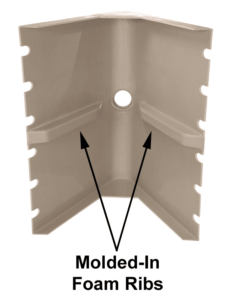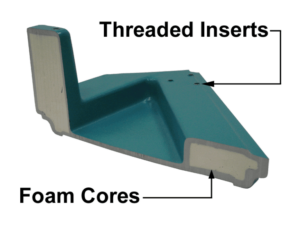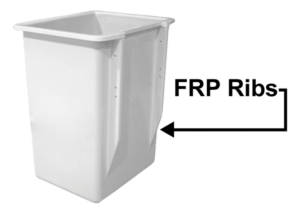Video: Amazing Impact Resistance of pDCPD Plastic
June 24, 2020The Difference Between UHMWPE and pDCPD
October 1, 2020For plastic molding projects, the quality and performance of a finished product start with its design. Several molding processes, like Resin Transfer Molding (RTM) and Reaction Injection Molding (RIM), are ideal for accommodating molded-in components that can improve both part quality and performance. Incorporating these composite materials can improve structural integrity or reduce secondary operations. When designed properly, complex plastic molded parts incorporating these components can result in lower production costs and higher strength.
 Advantages of Molded-In Composite Materials
Advantages of Molded-In Composite Materials
With custom thermosetting plastic molding processes such as RTM (Resin Transfer Molding) and RIM (Reaction Injection Molding), molded-in components are fully integrated into each part. Benefits of incorporating these components include:
Design Flexibility
The ability to customize a finished product is one of the most important advantages of molded-in composite materials. With nearly unlimited flexibility in product design, it allows for specific performance properties to fit applications of nearly any size. It also allows for several pieces to easily be combined into one part.
Improved Productivity
Because components can be molded directly into a part during the molding process, it essentially eliminates the need for any additional machining or assembly, which reduces the overall time and labor needed for completion.
Lower Post-Mold Material Costs
Because an RTM or RIM-molded part’s design can easily incorporate molded-in composite components, cost savings can be realized by eliminating materials and labor needed for secondary operations. The application of adhesives and mechanical fasteners as a secondary process to molding are just two examples of where molded-in components can reduce post-mold costs.
Types of Molded-In Features & Components
Common examples of materials used in molded designs (both composite and non-composite) include:
- Foam cores or ribs
- Hinges
- Handles
- Threaded inserts
- Brackets or plates
- Electrical conduit
- Metal or ABS piping
Molded-In Foam Cores or Ribs
Foam cores are particularly beneficial when incorporated into a plastic molded design. Foam cores help to add increased structural integrity, component stiffness, and even improve insulative properties. Due to its low density, a foam core within a finished plastic part can help reduce overall part weight.
In addition to foam cores, fiberglass-reinforced materials can also be molded into finished parts. An example of fiberglass-reinforced plastic (FRP) molded-in component is ribs, which add superior structural integrity to finished parts. First, the rib is molded using varying layers of fiberglass and the RTM manufacturing process. Upon completion, the RTM-molded ribs can be placed within the fiberglass layers of the complete part and over-molded, fully encapsulating and mechanically locking the rib within the finished part.
Contact the Molding Experts at Osborne
In addition to our custom plastics molding areas, we have several departments available to manufacture a variety of molded-in components. Structural foams and FRP ribs can be molded using low-cost composite molds while non-composite components can be manufactured in our metal fabrication area. Combining state-of-the-art equipment and a dedicated workforce of employee-owners, we’re able to handle almost any custom requirement for your project. To start collaborating with us on your next plastic molding project, please request a quote today.




